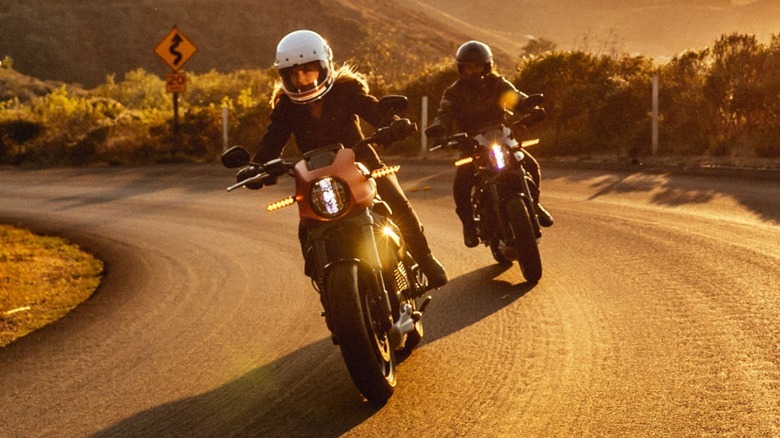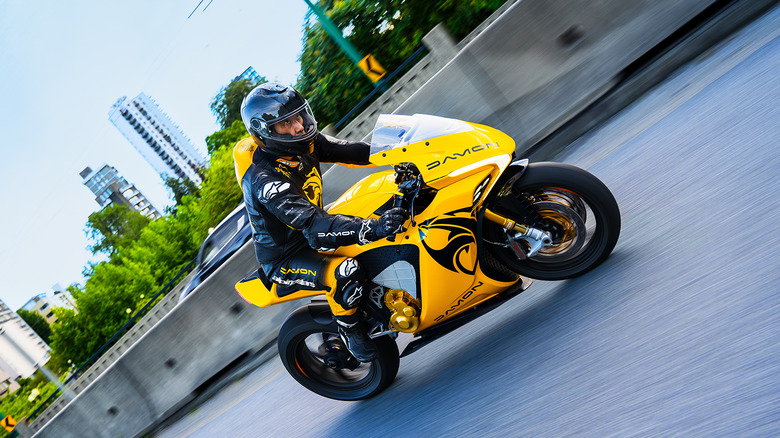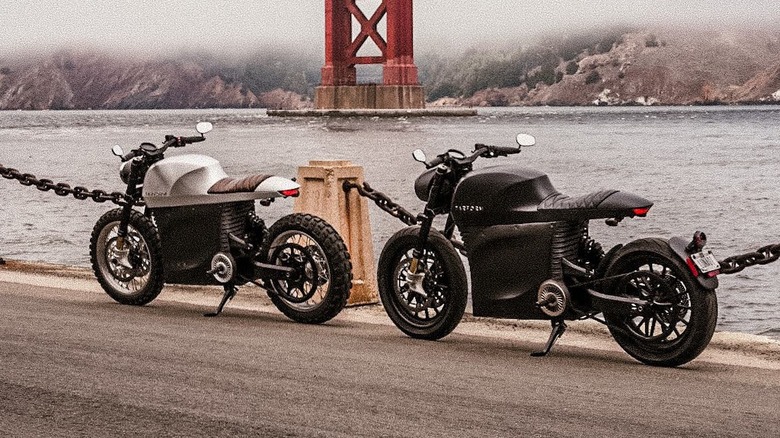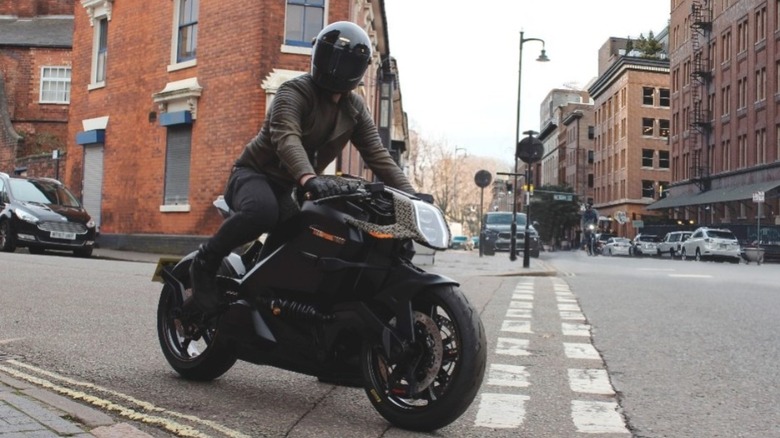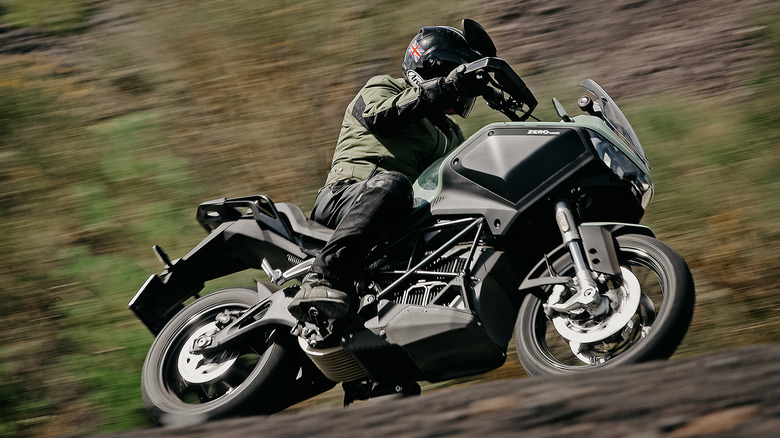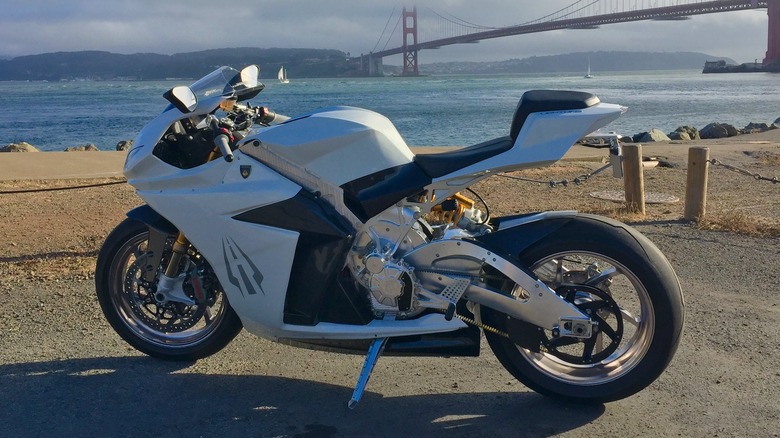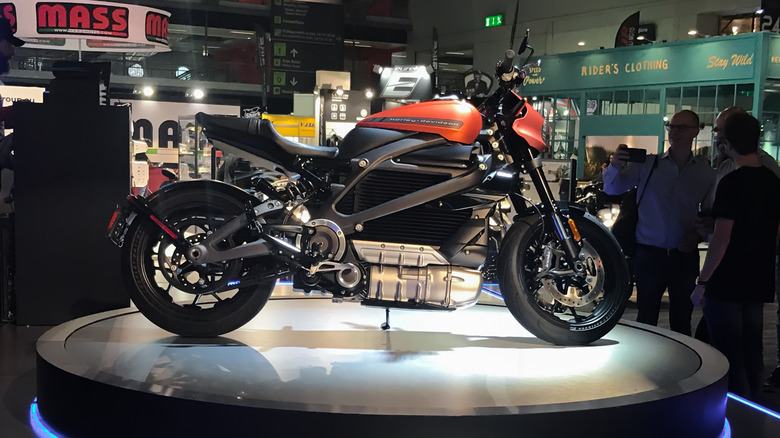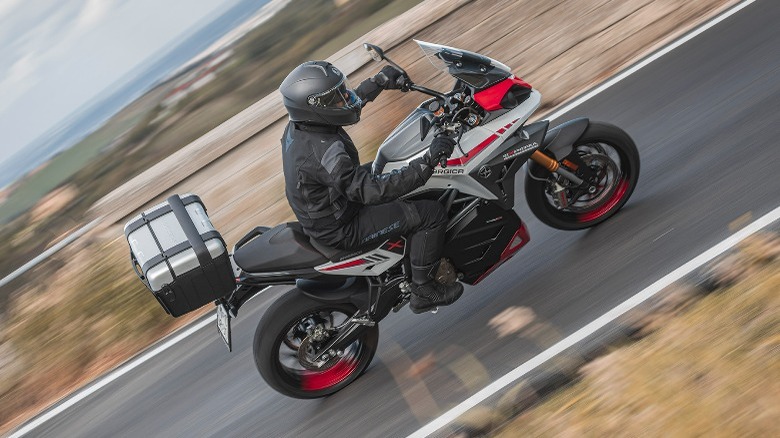The 7 Best Electric Motorcycles On The Market
The automotive industry is experiencing a sea change, with a thriving public interest in more eco-friendly vehicles that use sustainable materials, and the motorcycle segment is very much along for the ride. While electric motorcycles have not fully crossed over to the mainstream, there have been several bikes produced by both well-known brands and relatively new startups to fill this growing gap in the market, and some truly inspiring designs and innovations have been created to meet the practical demands of electric vehicles and improve the rider experience.
The rider experience is somewhat different on an electric motorcycle for various reasons. With no gear shifter, it's similar to operating a "twist and go" scooter rather than a regular iron horse with a standard manual transmission. While some gas-powered bikes have found success with automatic gears, such as Honda's Africa Twin option with the dual-clutch transmission, it can take some getting used to, and some might complain of losing the feel of a connection with the road. Electric vehicles are also much quicker than their fossil-fuel counterparts, so due care should be taken during the adjustment period. They are also much quieter, which can leave some riders missing the engine's note as they gun the throttle.
Whatever your thoughts on the electric motorcycle, it is undoubtedly here to stay and will likely become as commonplace as gas-powered options in the not-too-distant future. Here we have compiled our list of the best currently-available electric steeds for all types of terrains and riding styles.
Damon Hypersport Pro
Damon, a small Vancouver-based company, is making big waves in electric bike circles due to several staggering innovations that improve rider safety and experience across their range of vehicles. The Hypersport Pro, with its switchable rider position, is perhaps the most impressive of these. This allows the rider to flick a switch while in motion, and the handlebars drop while the footpegs swing up and backward, moving you into a more aggressive riding stance when in sports mode. This also allows the rider to choose a comfortable, upright seating position while on long tours, which is not so demanding on the back and shoulders.
Another exceptional benefit of the Hypersport Pro is its advanced safety features. It uses Blackberry technology (yes, they still exist) to continuously scan the road and warn you of hazards via haptic feedback in the handlebars and the onscreen display. Meanwhile, the bike's always-on front and rear cameras constantly monitor the road around you while relaying information to its bespoke CoPilot software.
As you might imagine, for a vehicle that is this technologically advanced, its specs are equally impressive. With an average range of 200 miles, a top speed of 200 miles per hour, a delivery of more than 200 Nm of torque, and an output of 200 horsepower (see a pattern here?), this bike is no slouch when it comes to performance. Add to this an acceleration of 0-60 miles per hour in under three seconds, and you have a machine that will give any fossil-fueled competitor a run for its money.
Tarform Luna
The environment might be a significant factor in your decision to go electric when shopping for a motorcycle, and when it comes to eco-friendly construction, the Tarform Luna does not disappoint. Tarform is a small Brooklyn, NY-based startup with a Swedish owner, and in true Scandinavian style, sustainable materials were high on the agenda when they first started creating their vehicles.
The materials used in the Tarform Luna's zero-waste construction include such bizarre elements as pineapple leaf fibers, flax seeds, and algae, as well as recycled aluminum body parts which lend it a burnished, steampunk appearance, like a cross between a café racer and an H.R. Giger painting. However, despite this stripped-down styling, the Luna is particularly well-equipped when it comes to onboard tech.
The Tarform Luna's lighting is all LED, and you have a choice of three rider modes to accommodate various road conditions and riding styles. While its circular high-definition instrument cluster features smartphone connectivity via Bluetooth, it does not appear overly complicated, but appearances can be deceptive. Inside is an impressive array of AI technology that relays information about upcoming potential hazards via haptic signals, allowing the rider to stay focused on the road ahead.
When it comes to performance, the Luna offers an acceptable range of 120 miles per charge, a top speed of around 120 miles per hour, and an acceleration of 0-60 mph in under four seconds. While these are not stellar specifications by electric motorcycle standards, it is nonetheless a perfectly capable bike for commuting or taking short day trips, and it's one of the most interesting in terms of construction and aesthetics.
Arc Vector
You get the impression that many designers sought to completely reimagine the motorcycle's appearance when tasked with designing an electric machine. This is certainly true of the British-made Arc Vector. While some bikes, such as the Triumph Rocket 3, look more like a caped crusader should straddle them than a mere mortal, the Vector, with its aggressive styling, swept-back fairing, and gravity-defying seat, has the appearance of the arch-nemeses motorbike of choice.
As with all other electric motorcycles, the Vector has no manual transmission. However, purists might appreciate its multiple switchable power modes, which give the rider more control over the powertrain than on other electric bikes. It also offers cruise control, which gives the rider's right wrist a break when trying to max out its highly-impressive 362-mile range. Should you need to exceed this mileage, you can fully recharge the Samsung battery in around 40 minutes, making this one of the most practical electric motorcycles on the market.
Touted by the brand as "the world's most advanced motorcycle," the Arc is notable for its performance as well as its looks. It has a top speed of 125 miles per hour, but this is limited by the manufacturer, and we cannot help but wonder what this beast could produce on the Utah salt flats with an uncapped engine. It offers traction control and rider modes as well as LED lighting, as you would expect on an electric motorcycle of this quality, but perhaps the most interesting aspect is its front-end suspension. Arc has dispensed with the usual fork-and-bearing design and has completely overhauled the system on a horizontal plane, giving this unique vehicle a truly futuristic appearance that looks worthy of an almost $120,000 price tag.
Zero DSR/X
The adventure biking segment has really taken off since the turn of the century, with motorcycles such as the Africa Twin, BMW R1200GS, and KTM 1190 Adventure dominating the market. It should come as no surprise, then, that the electric motorcycle industry wanted a piece of the action, and the Californian Zero DSR/X is possibly the best example of a large electric off-roader to challenge its petrol-powered cousins.
What is immediately apparent when you first meet the Zero is its authentic adventure-tourer styling, with its hand guards, bulky fairing, tubular frame, and skid plate underneath, all slightly reminiscent of gas-guzzling tourers like the Kawasaki Versys 1000 at a glance. Riders are treated to five rider modes, plus traction control and ABS braking, making this feel all the more like a tried-and-true adventure bike, especially when venturing off-road.
When it comes to performance, the Zero DSR/X is perfectly satisfactory, while it doesn't break any records. The top speed is capped at 111 miles per hour, and its range is also around the 111-mile mark. It provides an impressive 100 brake horsepower and fully recharges in an hour. As with most electric vehicles, acceleration is shockingly fast via the direct belt-drive transmission. However, the smart folks at Zero have modulated the powertrain to accelerate smoothly when prompted, to avoid sudden scares or loss of traction. The DSR/X comes with a companion app from Zero that allows you to, among other things, adjust your level of engine braking and your preferred battery economy settings. The app also pairs with the Cypher III+ onboard operating system to track the bike's performance specifications.
Lightning LS-218
If you are in the market for a high-performance electric sport bike, look no further than the Lightning LS-218. This machine has taken the industry by storm, and its specifications alone should shatter any doubts as to the potential of EV motorcycles. True to its name, the Lightning LS-218 is extremely fast. While the 218 in its title refers to its limited top speed in miles per hour, this is the quickest two-wheeler ever produced with a blistering 0-60 mph acceleration of 2.2 seconds.
The LS-218 comprises high-quality materials and parts, including carbon fiber fairings, Öhlins forks, and Brembo brake calipers and discs. It has preload-adjustable front and rear suspension, forged aluminum wheels, and a choice of three battery packs (the smallest at 12 kwh provides a range of around 100 miles, whereas the largest at 20 kwh delivers about 180 miles of range per charge). Its batteries take just 30 minutes to recharge with a fast charger, making this a practical option for long rides. However, when it comes to the Lightning LS-218, the real star of the show is its superbike motor. The IPM liquid-cooled direct-drive powertrain delivers 200 horsepower at 10,500 rpm and 168 ft-lbs of torque.
While it is easy to wax lyrical about the build quality, performance, and specs of the Lightning LS-218, it doesn't fall short in the looks department either. This seriously stylish sports bike gives its gas-powered competitors, such as the Triumph Daytona 675 and Kawasaki Ninja 650, some stiff competition. Its pointed cowl sweeps backward to provide excellent aerodynamics and is beset with four LED spot lamps on either side. Its fairings are nice and wide, and its footpegs are mounted high to facilitate the aggressive riding position that this bike demands.
Harley-Davidson LiveWire
Anyone who has seen the motorcycle documentary "The Long Way Up" will be familiar with Harley-Davidson EV bikes and will know that the classic Milwaukee marque is an innovator in electric motorcycle manufacture. This is surprising to many, as the brand has long been associated with gas-burning machines that are notoriously uneconomical and far from environmentally friendly. Conversely, Harley has made significant progress in the EV industry, and the latest Harley-Davidson LiveWire machine is packed with highly-evolved features while staying true to the brand's heritage.
The fact is that many riders, both old and new, are making the switch to electric bikes, and Harley Davidson did well to get ahead of the curve with its excellent LiveWire offering. Looks-wise it resembles a futuristic version of the brand's own Sportster range of motorbikes but with some notable differences, such as the single-sprung swingarm and the lack of chrome used overall. In fact, most of the bike's considerable bulk looks to be dedicated to its battery reserves, with the electric motor slapped to the chassis as an afterthought.
The LiveWire has proven to be a great success, thanks in no small part to its excellent handing, impressive recharge time of about an hour, respectable range of around 150 miles, and acceleration of 0-60 miles per hour in three seconds (this is, by a considerable margin, the fastest Harley-Davidson ever produced.) It is also loaded with tech features, including a high-definition display, a choice of seven ride modes, its RDRS rider defense system, and switchable sport, range, rain, and road options, to help you get the most out of your riding conditions.
Energica Experia
Just as the Zero DSR/X fills the gap in the electric adventure bike market, the Energica Experia is the EV answer to the popular adventure-touring segment. Much-lauded for its range and handling, the Experia is notable for being a mid-size electric adventure-touring that ranks alongside the petrol-powered Kawasaki Versys and Triumph Tiger in terms of styling and performance.
For a bike of this type, long days in the saddle are to be expected, and thankfully, Energica Experia has this covered. It has the distinction of having the largest battery capacity of any production motorcycle, but the battery weight has been distributed in such a way as to provide better balance to the vehicle, especially when riding off-road. The battery offers a top range of 261 miles for city commutes and a respectable average (combined) range of 160 miles. With a fast charging time of 45 minutes, you could break up your ride with a hearty lunch and be back on the road for the remainder of the afternoon when on an extended tour.
The Energica Experia's adjustable front and rear suspension from ZF Sachs contributes significantly to the bike's much-lauded handling prowess, with double Brembo front discs offering reliable and positive stopping power. ABS is provided, front and rear, for added braking control, and the overall construction is of very high quality, with a tubular steel frame, an aluminum swing arm, and aluminum side panels. The electronics match the build quality, with the Experia's 5-inch TFT display giving an overview of the six-level traction control, ABS settings, cruise control system, customizable riding modes (there are 15 in total), and its parking assistant (which has a reverse setting).
In short, with the Energica Experia, the Italian brand has created the best of both worlds: one of the best rider experiences with some of the best EV technology, and we are sure that even the most ardent petrolheads would not pass up the opportunity to take one of these for a ride.
